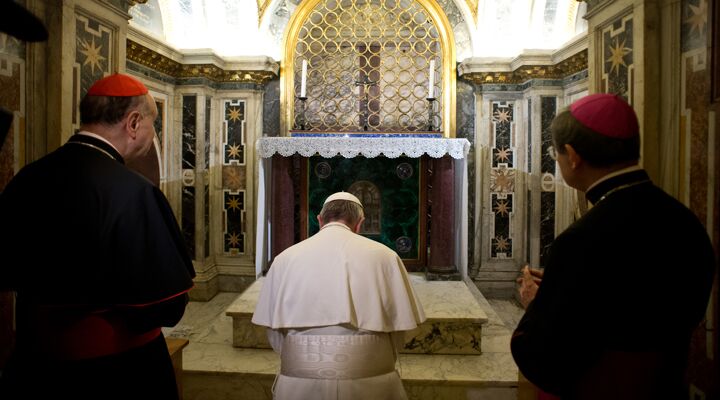
Did Pope Francis Visit the Apostle Peter’s Tomb?
Earlier this week the Vatican reported that Pope Francis spent part of his Easter Monday celebrations visiting the tomb of the original church leader Catholics would undoubtedly consider the most important pope in Roman Catholic history.
“Pope visits St. Peter’s tomb under Vatican,” read the April 1 Associated Press headline. The article reported,”Pope Francis on Monday took an emotional, close-up look at the tomb of Peter, the church’s first pontiff, buried beneath St. Peter’s Basilica, the Vatican said. By doing so, Francis became the first pontiff to visit the necropolis, where pagans and early Christians were buried, since extensive archaeological excavations were conducted at the ancient site decades ago, the Vatican said. … The Vatican first said Francis would pray at Peter’s tomb, but later said he prayed instead in the basilica.”
But is it the Apostle Peter’s bones that are buried in that tomb?
For centuries, the Christian world has taken for granted that the Apostle Peter is buried in Rome. This is no small issue, for upon it rests 2,000 years of papal authority and the very foundation of the Catholic Church. Presumably well over a quarter of the world’s population—1.2 billion Catholics plus most of the 1 billion other professing Christians—subscribe to this belief. Few, it seems, have thought to question this generally accepted tradition. Have you assumed it to be true?
The point at issue is very simple.
The central text for modern Christianity is purported to be the biblical New Testament. It documents that Simon Peter was the chief apostle of Jesus Christ. Was this same Simon Peter also the first pope—the man who originally founded the Roman Catholic Church and established it in the mid-40s a.d. in Rome, as is almost universally believed? Is this Apostle Peter buried beneath the Vatican, in what is referred to as “the most highly venerated martyr’s shrine in the West”? If not, who is? The facts are bound to surprise you.
AP goes on to say, “Francis, as a Jesuit, is steeped in the evangelizing mission of the church, and the necropolis tour brings him back to the origins of the church in its simplest years as a community of Christians …” (emphasis added).
But what truly were the origins of the universal church? How was it established in Rome, and if not by the Apostle Peter, then by whom?
On Monday, after first pausing in the Sistine Chapel to pray, Pope Francis descended beneath the chapel, ostensibly for a “visit of devotion” to the one particularly renowned tomb. During his 45-minute tour of the necropolis, the pope “climbed up a bit, got closer to the place where the tomb of St. Peter lies, exactly under the central altar and the dome of the basilica,” the Vatican said.
Most believe the tomb of the first Catholic pope, said to be underneath St. Peter’s Basilica in Rome, houses the bones of the Apostle Peter, despite the fact that, as the Catholic Encyclopedia admits, “We possess no precise information regarding the details of [Peter’s] Roman sojourn.”
Indeed, nowhere in the biblical narrative is there any record of Peter going to or staying in Rome. Neither is there any mention of Peter establishing the church in that chief city of the Roman Empire. In fact, it is the Apostle Paul who is clearly documented as being responsible for the ministry to the Gentiles, including Italy and its capital, Rome (e.g. Romans 11:13). The Encyclopedia of Religion and Ethics is forced to admit that “the New Testament supplies nothing which could give rise to a legend that St. Peter visited Rome. On the contrary, the narrative of the Acts and the notices in St. Paul’s later epistles seem to make such a visit improbable” (James Hastings; Volume ix).
So, the biblical record directly contradicts popular belief and professed papal history.
In addition, historical evidence and recorded facts clearly reveal that rather than being buried in Rome, Peter’s bones were interred in an entirely different country, whose state religion is not even Roman Catholic.
A letter written by an early predecessor of Pope Francis clearly records that the Catholic Church sent the bones of the apostles Peter and Paul—referred to as relics in his letter—from Rome to Britain. It is widely documented that the 76th pope—Vitalian—during his 14-year reign in Rome, entered into correspondence with Oswy, the British king. An excerpt from one of his letters states, “However, we have ordered the blessed gifts of the holy martyrs, that is, the relics of the blessed apostles, Peter and Paul, and of the holy martyrs Laurentius, John and Paul, and Gregory, and Pancratius, to be delivered to the bearers of these our letters, to be by them delivered to you” (Bede, Ecclesiastical History of the English Nation, Book iii).
So whose remains does this most highly venerated shrine actually house?
Although they possess no specific evidence Peter ministered in Rome, and the Bible is silent on the matter, most professing Christians accept the assurance of Catholic tradition, belief and teaching that the Apostle Peter was the first pope and is buried in Vatican City.
However, the Bible, the historical record and even the pen of the 76th pope confirm the Apostle Peter was not the first pope. Clearly they are not his bones that are buried beneath the Vatican. The Bible teaches us to “prove all things, hold fast to that which is true”—and speaking of God’s recorded words, “thy word is truth” (1 Thessalonians 5:21; John 17:17). You can prove the truth in this matter—and discover the facts about the foundation of God’s Church. Request or read online our reprint articles “Mystery of the Church” and “New Testament Church Begins,” and also Mystery of the Ages, paying particular attention to Chapter Six, “Mystery of the Church.”
